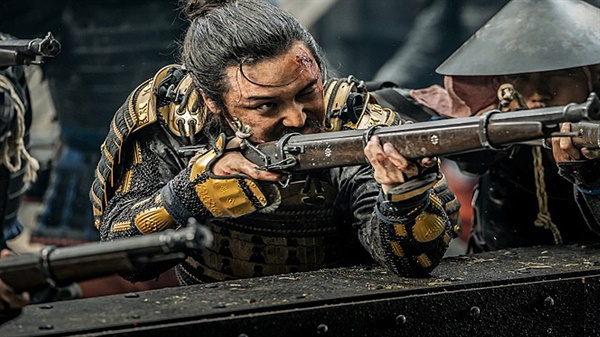




Yi Sun-sin's War is dramatic because he ended the Joseon Dynasty, which was shaken to its roots, with the capital Hanyang falling and the king, the ancestor, leaving Pacheon in 20 days after the opening of the War. There is a slight difference depending on the interpretation, but it is difficult to find in the former World Warrior beyond the Joseon Dynasty, not losing a single defeat and not losing a single front in the Korean War Veterans Memorial before more than 40 times.
Director Kim Han-min, one of the historical experts in the Korean film industry, shows a special interest in Yi Sun-sin. In 2014, he illuminated Chungmugong's most dramatic War with The Admiral: Roaring Currents, and in eight years, he revealed that his task was not a one-off project with The Emergence of the Hansan Dragon. He once again used Park Hae-il, who starred in his previous work, "The Final Armed bow," to capture the general's determination in his blank face.
hansan counterintelligence is remembered as the Battle of Okinawa, which determines the national fortune of Joseon during the Japanese invasion of Korea. In less than two months after the opening of the War, Hanyang and Pyongyang fell into the hands of the enemy, and the battlefield tilted sharply to the army. Under the plan of the amphibious army, the first group of Konishi Yukinaga, who occupied Pyongyang, prepared for the march on the premise of supply through the west coast. The ancestors, who were so busy with their rituals, were ready to cross the river if their names were allowed to go down.
hansan counterintelligence is the Battle of Okinawa, which secured the sea-breaking rights of the southwestern coast with one fight. Forty-seven Warships were sunk, twelve were captured, and the enemy, Yasu Wakizaka (Byun Yo-han), managed to save his life after escaping and drifting. The Joseon Fleet was not damaged by a single scale, and only three were killed.
Director Kim Han-min draws the Ichi Battle of Okinawa with hansan counterintelligence. The Emergence of the Hansan Dragon and the Battle of Okinawa are the decisive battles of Okinawa, which will lead War to victory by preserving Jeolla Province, and are meaningful moments in which two heroes of the Japanese invasion of Korea, Yi Sun-sin and Kwon Yul, played respectively. Interestingly, the two Battle of Okinawas took place on the same day, and the film was described as a request for cooperation by Haru, the commander of the hansan counterintelligence, sending a messenger to Ichi Battle of Okinawa's Waegun commander Kobayaka and Takakage several times.
Takakage is a long-lived Japanese Warrior who stands out among the Korean War Veterans Memorial Japanese Japanese Japanese invasions in the Japanese invasion of Korea. Unlike Hideyoshi's vassal or sodai mausoleum, he is a person who left a great name in the Japanese national era. Hideyoshi, who unified the whole country, said, "If you leave the west to Takakage and the east to Ieyasu, there is nothing to worry about."
The director changed history and set up Yasu and Takakage to cooperate with General Yi Sun-sin in the field of Jeollajwa Swimming, which seems to be intended to create dramatic tension. In addition to this, the Turtle ship, which is only a supporting role in the hansan counterintelligence, is also a variation to further dramatize the hansan counterintelligence. It is because the rescue of Danger and Turtle ship of Panokseon, which attracted the enemy line rather than the overwhelming bombardment, and the division of the isolated Turtle ship make the movie look more dramatic.
In addition, the scene of referring to the Battle of Okinawa, which appears to be the Battle of Okinawa, as the Battle of Okinawa, or the scene of Kamei Gorenori describing the golden debt given to Toyotomi Hideyoshi as Yasu's, and the disguised Yi Sun-sin, Lee Woon-ryong (Park Hoon-sin) There are also many attempts to describe history differently, including the setting of Boone as a teacher, the modification of the Turtle ship to enter and exit the neck, and the scene of Kiyomasa Kato (Kim Sung-kyun), who was active in capturing the princes of Joseon while sweeping Hamgyeongdo, taking away the navy from Yasu.
As in The Admiral: Roaring Currents, the film also features the intelligence of both armies and the performance of the surrendered Japanese army. It reflects the careful aspect of the general who emphasized the thorough grasp of the enemy's information, and it is a part of making the movie a little colorful.
The overwhelming naval battle that was seen in is still there. Despite the Hollywood masterpiece 300: Resurrection of the Empire, which was released in the same year, dealing with the Battle of Salamis, one of the world's naval battles, director Kim Han-min faithfully proved that the technical capabilities of Korean films are never lacking. The emergence of the Hansan Dragon showed that eight years of time was not wasted by drawing more precise bombardment and paralysis than the previous work.
Kim Han-min's filmography, which leads to the evolution of the Hansan Dragon, is an example of how history can be used as an endless material of the cultural industry. This means that not only the Battle of Okinawa of Yi Sun-sin, which is unbeaten in 45 Wars, but also the activities of Army longevity including Kwon Yul, and all the history of the Korean peninsula can be the material of the film and succeed in the box office.
It's published with the critic: Searching for 'Cine Manse' will allow you to see more articles.